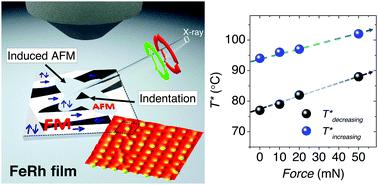当前位置:
X-MOL 学术
›
Mater. Horiz.
›
论文详情
Our official English website, www.x-mol.net, welcomes your
feedback! (Note: you will need to create a separate account there.)
Local manipulation of metamagnetism by strain nanopatterning
Materials Horizons ( IF 12.2 ) Pub Date : 2020-05-14 , DOI: 10.1039/d0mh00601g Michael Foerster 1, 2, 3, 4 , Enric Menéndez 4, 5, 6, 7 , Emerson Coy 8, 9, 10, 11 , Alberto Quintana 4, 5, 6, 7 , Carles Gómez-Olivella 4, 12, 13, 14 , Daniel Esqué de los Ojos 4, 5, 6, 7 , Oriol Vallcorba 1, 2, 3, 4 , Carlos Frontera 4, 15, 16 , Lucia Aballe 1, 2, 3, 4 , Josep Nogués 4, 17, 18, 19, 20 , Jordi Sort 4, 5, 6, 7, 21 , Ignasi Fina 4, 15, 16
Materials Horizons ( IF 12.2 ) Pub Date : 2020-05-14 , DOI: 10.1039/d0mh00601g Michael Foerster 1, 2, 3, 4 , Enric Menéndez 4, 5, 6, 7 , Emerson Coy 8, 9, 10, 11 , Alberto Quintana 4, 5, 6, 7 , Carles Gómez-Olivella 4, 12, 13, 14 , Daniel Esqué de los Ojos 4, 5, 6, 7 , Oriol Vallcorba 1, 2, 3, 4 , Carlos Frontera 4, 15, 16 , Lucia Aballe 1, 2, 3, 4 , Josep Nogués 4, 17, 18, 19, 20 , Jordi Sort 4, 5, 6, 7, 21 , Ignasi Fina 4, 15, 16
Affiliation

|
Among metamagnetic materials, FeRh alloys are technologically appealing due to their uncommon antiferromagnetic-to-ferromagnetic metamagnetic transition which occurs at a temperature T* just above room temperature. Here, a controlled increase of T* (ΔT* ∼ 20 °C) is induced in pre-selected regions of FeRh films via mechanical strain nanopatterning. Compressive stresses generated at the vicinity of pre-defined nanoindentation imprints cause a local reduction of the FeRh crystallographic unit cell parameter, which leads to an increase of T* in these confined micro-/nanometric areas. This enhances the stability of the antiferromagnetic phase in these localized regions. Remarkably, generation of periodic arrays of nanopatterned features also allows modifying the overall magnetic and electric transport properties across large areas of the FeRh films. This approach is highly appealing for the design of new memory architectures or other AFM-spintronic devices.
中文翻译:

通过应变纳米图案局部控制超磁性
在超磁性材料中,FeRh合金在技术上具有吸引力,因为它们在温度T *刚好高于室温时会发生不常见的反铁磁-铁磁亚磁转变。在此,通过机械应变纳米图案化,在FeRh膜的预选区域中引起了T *(ΔT *〜20°C)的受控增加。在预定义的纳米压痕印记附近产生的压应力会导致FeRh晶体学晶胞参数的局部降低,从而导致T的增加*在这些受限的微米/纳米区域。这增强了这些局部区域中反铁磁相的稳定性。显着地,纳米图案化特征的周期性阵列的产生还允许改变跨FeRh膜的大面积的整体磁和电传输性质。这种方法对于设计新的存储器架构或其他AFM自旋电子设备非常有吸引力。
更新日期:2020-05-14
中文翻译:

通过应变纳米图案局部控制超磁性
在超磁性材料中,FeRh合金在技术上具有吸引力,因为它们在温度T *刚好高于室温时会发生不常见的反铁磁-铁磁亚磁转变。在此,通过机械应变纳米图案化,在FeRh膜的预选区域中引起了T *(ΔT *〜20°C)的受控增加。在预定义的纳米压痕印记附近产生的压应力会导致FeRh晶体学晶胞参数的局部降低,从而导致T的增加*在这些受限的微米/纳米区域。这增强了这些局部区域中反铁磁相的稳定性。显着地,纳米图案化特征的周期性阵列的产生还允许改变跨FeRh膜的大面积的整体磁和电传输性质。这种方法对于设计新的存储器架构或其他AFM自旋电子设备非常有吸引力。









































 京公网安备 11010802027423号
京公网安备 11010802027423号